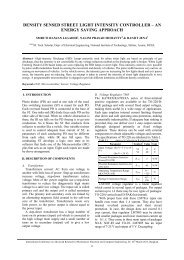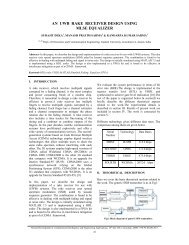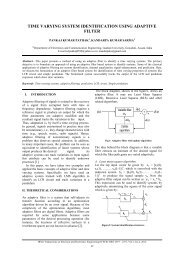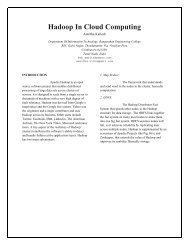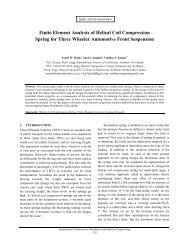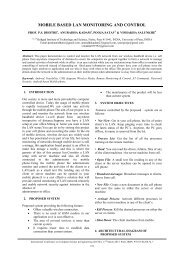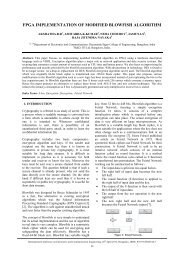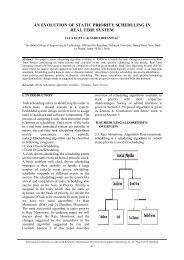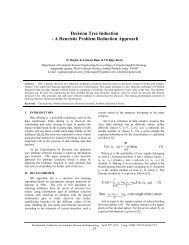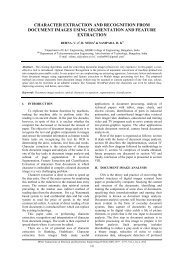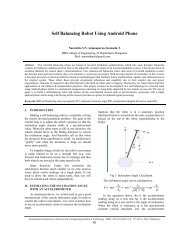Union of RSA algorithm, Digital signature And ... - IRNet Explore
Union of RSA algorithm, Digital signature And ... - IRNet Explore
Union of RSA algorithm, Digital signature And ... - IRNet Explore
Create successful ePaper yourself
Turn your PDF publications into a flip-book with our unique Google optimized e-Paper software.
<strong>Union</strong> <strong>of</strong> <strong>RSA</strong> <strong>algorithm</strong>, <strong>Digital</strong> <strong>signature</strong><br />
<strong>And</strong> KERBEROS in cloud security<br />
Mehdi Hojabri & Mona Heidari<br />
Department <strong>of</strong> CS and SE <strong>And</strong>hra University , Vizag, India<br />
E-mail : hozhabri64@gmail.com, monaheid@gmail.com<br />
Abstract - as we know cloud computing is one <strong>of</strong> the famous part <strong>of</strong> IT enterprise and nowdays it make many challange for growing<br />
the security issues. The security is most important for all domain in computer network and also the cloud is one facility with internet<br />
platform. All user, company and enterprise for using the cloud,at the frist they expect more secure,reliable and relation issues. In this<br />
paperwe enhance the security issues in cloud computing with mixed three security service such as:<br />
• Kerberos authentication service<br />
• Rsa <strong>algorithm</strong><br />
• <strong>Digital</strong> <strong>signature</strong><br />
• Admin<br />
We used the kerberos authentication service for issues the ticket and granting ticket for all users just for make more security. <strong>Digital</strong><br />
<strong>signature</strong> with <strong>RSA</strong> <strong>algorithm</strong>, to encrypting the data while we are transferring it over the network. A digital <strong>signature</strong> or digital<br />
<strong>signature</strong> scheme is a mathematical scheme for demonstrating the authenticity <strong>of</strong> a digital message or document. At the first all users<br />
for connecting to the cloud they should make the pr<strong>of</strong>ile and geting the password from kerberos and after that they can entry to cloud<br />
realm for using the cloud and share the information with effect <strong>of</strong> Rsa <strong>algorithm</strong> and digital <strong>signature</strong>. In this article we define a<br />
admin.Admin should make the restrict for all user according their IP.<br />
Keywords: Rsa <strong>algorithm</strong> , <strong>Digital</strong> <strong>signature</strong> , kerberos authentication service,Admin.<br />
I. INTRODUCTION<br />
A cloud computing facility, paired with<br />
technologies such as netbooks, rich internet applications<br />
, smart phones, and web services, allows users to run<br />
their applications anywhere and access to the desire<br />
services at any time. The security in the cloud is one <strong>of</strong><br />
the most important issues. Already many researcher,<br />
survey cloud security problem with rsa <strong>algorithm</strong> and<br />
digital <strong>signature</strong>. But we add another service for<br />
enhance the security issues. This service is kerberos<br />
authentication service. In this theory admin define some<br />
IP address for using the cloud server provider. It means<br />
admin make restrict for some user. At the next step the<br />
user with that IP address can connect to the kerberos and<br />
after this service it should connect to the cloud service<br />
provider for sending the data with influence <strong>of</strong> digital<br />
<strong>signature</strong> and rsa <strong>algorithm</strong>. So i think with this long<br />
filtering we can enhance the security problem in the<br />
cloud.<br />
International Conference on S<strong>of</strong>tware Technology and Computer Engineering (STACE-2012), ISBN : 978-93-81693-68-1, 22 nd July 2012,Vijayawada<br />
49<br />
II. THE CLOUD COMPUTING STACK<br />
We can define cloud Computing as a stackin 3<br />
domain. Below we define tree type <strong>of</strong> cloudstack:<br />
A. S<strong>of</strong>tware as a Service<br />
B. Platform as a Service<br />
C. Infrastructure as a Service<br />
• S<strong>of</strong>tware as a Service<br />
s<strong>of</strong>tware that is deployed over the internet… With<br />
SaaS,a provider licenses an application to customers<br />
either as a service on demand, through a subscription, in<br />
a “pay-as-you-go” model, or (increasingly) at no charge<br />
when there is opportunity to generate revenue from<br />
streams other than the user, such as from advertisement<br />
or user list sales. SaaS is a rapidly growing market as<br />
indicated in recent reports that predict ongoing double<br />
digit growth. This rapid growth indicates that SaaS will<br />
soon become commonplace within every organization<br />
and hence it is important that buyers and users <strong>of</strong>
<strong>Union</strong> <strong>of</strong> <strong>RSA</strong> <strong>algorithm</strong>, <strong>Digital</strong> <strong>signature</strong> <strong>And</strong> KERBEROS in cloud security<br />
technology understand what SaaS is and where it is<br />
suitable.<br />
• Characteristics <strong>of</strong> SaaS<br />
• Web access to commercial s<strong>of</strong>tware.<br />
• S<strong>of</strong>tware is managed from a central location .<br />
• S<strong>of</strong>tware delivered in a one to many model.<br />
• Users not required to handle s<strong>of</strong>tware upgrades and<br />
patches.<br />
• Application Programming Interfaces allow for<br />
integration between different pieces <strong>of</strong> s<strong>of</strong>tware.<br />
• Platform as a Service<br />
Platform as a Service (PaaS) brings the benefits that<br />
SaaS bought for applications,but over to the s<strong>of</strong>tware<br />
development world. PaaS can be defined as a computing<br />
platform that allows the creation <strong>of</strong> web applications<br />
quickly and easily and without the complexity <strong>of</strong> buying<br />
and maintaining the s<strong>of</strong>tware and infrastructure<br />
underneath it.PaaS is analogous to SaaS except that,<br />
rather than being s<strong>of</strong>tware delivered over the web, it is a<br />
platform for the creation <strong>of</strong> s<strong>of</strong>tware, delivered over the<br />
web.<br />
• Characteristics <strong>of</strong> PaaS:<br />
• Services to develop,test, deploy, host and maintain<br />
applications in the same integrated development<br />
environment. All the varying services needed to<br />
fulfil the application development process.<br />
• Web based user interface creation tools help to<br />
create, modify, test and deploy different UI<br />
scenarios.<br />
• Multi-tenant architecture where multiple concurrent<br />
users utilize the same development application.<br />
• Built in scalability <strong>of</strong> deployed s<strong>of</strong>tware including<br />
load balancing and failover.<br />
• Integration with web services and databases via<br />
common standards.<br />
• Support for development team collaboration – some<br />
PaaS solutions include project planning and<br />
communication tools.<br />
• Tools to handle billing and subscription<br />
management.<br />
• Infrastructure as a Service<br />
Infrastructure as a Service (IaaS) is a way <strong>of</strong><br />
delivering Cloud Computing infrastructure servers,<br />
storage, network and operating systems – as an on-<br />
demand service. Rather than purchasing servers,<br />
s<strong>of</strong>tware, datacenter space ornetwork equipment, clients<br />
instead buy those resources as a fully outsourced<br />
service on demand.<br />
• Characteristics <strong>of</strong> IaaS<br />
• Resources are distributed as a service<br />
• Allows for dynamic scaling<br />
• Has a variable cost, utility pricing model<br />
• Generally includes multiple users on a single piece<br />
<strong>of</strong> hardware<br />
III. PROBLEM STATEMENT<br />
• Kerberos authentication service<br />
Kerberos is one <strong>of</strong> secure method for authenticating<br />
a request for a service in a computer network. Kerberos<br />
was developed in the Athena Project at the<br />
Massachusetts Institute <strong>of</strong> Technology.The name is<br />
taken from Greek mythology. Kerberos was a three<br />
headed dog who guarded the gates <strong>of</strong> Hades.Users after<br />
send the request,they can take ticket and granting ticket<br />
and finally that can be used to request a particular<br />
servicefromaserver.Theuser'spassword does not have to<br />
pass through the network.<br />
• <strong>RSA</strong> <strong>algorithm</strong><br />
<strong>RSA</strong> was created by Ron Rivest, Adi Shamir, and<br />
Leonard Adleman in 1978. The <strong>RSA</strong> scheme is a block<br />
cipher in which the plaintext and cipher text are integers<br />
between 0 and n-1 for some n. A typical size for n is<br />
1024 bits, or 309 decimal digits.That is, n is less than<br />
21024.<br />
Till now, it is the only asymmetric (i.e. needs two<br />
different keys) <strong>algorithm</strong> used for private/public key<br />
generation and encryption.<strong>RSA</strong> is widely used in<br />
electronic commerce protocols, and is believed to be<br />
sufficiently secure given sufficiently long keys and the<br />
use <strong>of</strong> up-to-date implementations.fig.1<br />
The <strong>RSA</strong> <strong>algorithm</strong> involves three steps:<br />
• Key generation<br />
• Encryption<br />
• Decryption<br />
• <strong>Digital</strong> <strong>signature</strong><br />
A digital <strong>signature</strong> or in simple manner is<br />
handwritten <strong>signature</strong>. Is a authenticates electronic<br />
documents. This <strong>signature</strong> cannot be fake and it asserts<br />
that a named person wrote or otherwise agreed to the<br />
document to which the <strong>signature</strong> is attached. The<br />
International Conference on S<strong>of</strong>tware Technology and Computer Engineering (STACE-2012), ISBN : 978-93-81693-68-1, 22 nd July 2012,Vijayawada<br />
50
<strong>Union</strong> <strong>of</strong> <strong>RSA</strong> <strong>algorithm</strong>, <strong>Digital</strong> <strong>signature</strong> <strong>And</strong> KERBEROS in cloud security<br />
recipient <strong>of</strong> a digitally signed message can verify that<br />
the message originated from the person whose <strong>signature</strong><br />
is attached to the document and that the message has not<br />
been altered either intentionally or accidentally since it<br />
was signed. Also, the signer <strong>of</strong> a document cannot later<br />
disown it by claiming that the <strong>signature</strong> was forged. In<br />
other words, digital <strong>signature</strong>s enable the<br />
“authentication” and “non-repudiation” <strong>of</strong> digital<br />
messages, assuring the recipient <strong>of</strong> a digital message <strong>of</strong><br />
both the identity <strong>of</strong> the sender and the integrity <strong>of</strong> the<br />
message.<br />
IV. DIGITAL SIGNATURE WITH <strong>RSA</strong><br />
ENCRYPTION ALGORITHM AND<br />
KERBEROS TO ENHANCE DATA<br />
SECURITY IN CLOUD<br />
In Cloud computing, we have many problem like<br />
security <strong>of</strong> data, files system, backups, network traffic,<br />
host security,alter the data and many more.Here at the<br />
first we are proposing a concept <strong>of</strong> kerbros<br />
authentication service for issues the ticket for all<br />
participating over the network. In this article we suppose<br />
any user or client for using the cloud and connecting to<br />
cloud, at the fist they must connect to the kerberos and<br />
make the pr<strong>of</strong>ile <strong>of</strong> information in kerberos data base for<br />
more secure.At the next step the AS <strong>of</strong> kerberos do<br />
verifies usere and created the ticket granting ticket and<br />
session key and it sent to the users. the next step users<br />
send the ticket granting ticket and session key to TGS<br />
for get the service. In the next step the TGS send ticket<br />
and session key for user.In final step the users send the<br />
request service to cloud service provider for using the<br />
cloud service and also cloud service, provide service<br />
tousers. The process <strong>of</strong> this scenario is in five step:<br />
A. The client logs on the workstation and send the<br />
requests access a ticket-granting ticket on behalf <strong>of</strong><br />
the user by sending its user’s ID to the AS, together<br />
with TGS ID, indicating a request to use the TGS<br />
service.<br />
B. The AS responds with a ticket that is encrypted<br />
with a key that is derived from user password.<br />
When this response arrives at the client, the client<br />
prompts the user for his or her password, generates<br />
the key, and attempt decrypt the incoming message.<br />
If the correct password is supplied, the ticket is<br />
successfully recovered. Because only the correct<br />
user should know the password, only the correct<br />
user can recover the ticket. Thus, we have used the<br />
password to obtain credentials from kerberos<br />
without having to transmit the password in<br />
plaintext. The ticket itself consist <strong>of</strong> the ID and<br />
network address <strong>of</strong> the user, and the ID <strong>of</strong> the TGS.<br />
This corresponds to the first scenario. This is that<br />
this ticket can be used by the client to request<br />
multiple cloud service granting tickets. So the ticket<br />
granting ticket is to be reusable. However,we do not<br />
wish an opponent capture the ticket and waits until<br />
the user has logged <strong>of</strong>f his or her workstation. The<br />
opponent either gain access to that work station or<br />
configure his workstation with the same network<br />
address as that <strong>of</strong> the victim.The ticket include a<br />
timestamp ,indicating the data and time for which<br />
the ticket was issued,and a lifetime, indicating the<br />
length <strong>of</strong> time for which the ticket is valid. Thus,the<br />
client know has a reusable ticket and need not<br />
bother the user for a password for each new service<br />
request.<br />
C. The client request a service-granting ticket on<br />
behalf <strong>of</strong> the user. For this purpose,the client<br />
transmits a message to the TGS containing the<br />
user’s ID,the ID <strong>of</strong> the desire cloud service,and the<br />
ticket-granting ticket.<br />
D. The TGS decrypt the incoming ticket and verifies<br />
the success <strong>of</strong> the decryption by the presence <strong>of</strong> its<br />
ID. It check to make sure that the lifetime has not<br />
expired. Then it compares the user ID and network<br />
address with the incoming information to<br />
authenticate the user. If the uses is permitted access<br />
to V, the TGS issues a ticket to grant access to the<br />
requested cloud service provider. The servicegranting<br />
provider ticket has the same structure as<br />
the ticket-granting ticket.Indeed,because the TGS is<br />
a server,we would expect that the same elements<br />
are needed to authenticate a client to the TGS and to<br />
authenticate a client to an application server.<br />
Again,the ticket contain a timestamp and lifetime. If<br />
the user wants access to the same cloud service at a<br />
later time,the client can simply use the previously<br />
acquired service-granting ticket and need not bother<br />
the user for a password. Note that the ticket is<br />
encrypted with a secret key(Kv) known only to the<br />
TGS and the server, preventing alteration. Finally,<br />
with a particular cloud service –granting ticket, the<br />
client can gain access to the corresponding service<br />
with next step.<br />
E. The user request access to cloud service on behalf<br />
<strong>of</strong> the user. For this purpose the client transmits a<br />
message to the server containing the user’s ID and<br />
the cloud service granting ticket, The server<br />
authentication by using the contents <strong>of</strong> the ticket.<br />
After this process the users can used the cloud<br />
service provider, but for making more secure we define<br />
the Rsa <strong>algorithm</strong> and digital <strong>signature</strong> in the cloud<br />
realm. All users at the first must pass the filter <strong>of</strong><br />
kerberos and the second they can entry to cloud realm,<br />
after entry to cloud realm and taking the cloud service,<br />
for more secure they must doing follow the Rsa<br />
<strong>algorithm</strong> and digital <strong>signature</strong>.<br />
International Conference on S<strong>of</strong>tware Technology and Computer Engineering (STACE-2012), ISBN : 978-93-81693-68-1, 22 nd July 2012,Vijayawada<br />
51
<strong>Union</strong> <strong>of</strong> <strong>RSA</strong> <strong>algorithm</strong>, <strong>Digital</strong> <strong>signature</strong> <strong>And</strong> KERBEROS in cloud security<br />
Assume we have two enterprises A and B. These<br />
enterprise passed the kerberos filtering after that An<br />
enterpriseA have a public cloud server with data,<br />
applications and many more thing. Company B wants a<br />
secure data from A Cloud. We are here, trying to send a<br />
secure data to B by using <strong>Digital</strong> <strong>signature</strong> with <strong>RSA</strong><br />
<strong>algorithm</strong>. We are taking some steps to implementing<br />
<strong>Digital</strong> <strong>signature</strong> with <strong>RSA</strong> encryption <strong>algorithm</strong>.<br />
Suppose we have two employee in this scenario: Ali<br />
and Reza.<br />
Step1.Ali takes a document from cloud, which Reza<br />
wants.<br />
Step2.The document will crunched into few lines by<br />
using some Hash function.Fig.2<br />
Step 3. Ali s<strong>of</strong>tware then encrypts the message digest<br />
with his private key. The result is the digital<br />
<strong>signature</strong>.Fig.3<br />
Step 4. Using <strong>RSA</strong> Algorithm, Ali will encrypt digitally<br />
signed <strong>signature</strong> with Reza public key and Reza will<br />
decrypt the cipher text to plain text with his private key<br />
and Ali public key for verification <strong>of</strong><strong>signature</strong>.<br />
All this step act according the ticket granting ticket.<br />
Fig.1 Rsa <strong>algorithm</strong><br />
Fig.2 Message Digest<br />
Fig.3 Encryption <strong>of</strong> message digest into Signature<br />
CONCLUSION<br />
As we read in this article, we survey the problem in<br />
cloud service provider. Already some researcher did the<br />
enhance security problem in cloud with effect <strong>of</strong> rsa<br />
<strong>algorithm</strong> and digital <strong>signature</strong>. But in this paper we<br />
investigated the security issues in cloud service with<br />
effect <strong>of</strong> authentication service. I mean we do the<br />
combination <strong>of</strong> three service such as:<br />
• Rsa <strong>algorithm</strong><br />
• <strong>Digital</strong> <strong>signature</strong><br />
• Kerberos<br />
We propose the new innovation for improving the<br />
security problem in cloud computing. In my opinion in<br />
this paper we define one way for enhance the security<br />
problem with three filtering. At the first each IP must be<br />
confirm with admin.Secont they should apply for taking<br />
the ticket.Finally they can catch the cloud service<br />
provider,but in the cloud realm they must use the rsa<br />
<strong>algorithm</strong> and digital <strong>signature</strong> for sending the<br />
information.<br />
REFERENCE<br />
[1] Uma Somani, Kanika Lakhani and Manish Mundra<br />
“Implementing <strong>Digital</strong> Signature with <strong>RSA</strong><br />
Encryption Algorithm to Enhance the Data Security<br />
<strong>of</strong> Cloud in Cloud Computing”, 2010 1st<br />
International Conference on Parallel, Distributed<br />
and Grid Computing (PDGC - 2010).<br />
[2] Kresimir Popovic and Zeljko Hocenski “Cloud<br />
computing security issues and challenges”,<br />
MIPRO 2010, May 24-28, 2010, Opatija, Croatia.<br />
International Conference on S<strong>of</strong>tware Technology and Computer Engineering (STACE-2012), ISBN : 978-93-81693-68-1, 22 nd July 2012,Vijayawada<br />
52
<strong>Union</strong> <strong>of</strong> <strong>RSA</strong> <strong>algorithm</strong>, <strong>Digital</strong> <strong>signature</strong> <strong>And</strong> KERBEROS in cloud security<br />
[3] Richard Chow, Philippe Golle, Markus<br />
Jakobsson,Ryusuke Masuoka, Jesus Molina Elaine<br />
Shi, Jessica Staddon, Ryusuke Masuoka, and Jesus<br />
Molina “Controlling Data in the Cloud:<br />
Outsourcing Computation without Outsourcing<br />
Control”,CCSW 09, November 13, 2009, Chicago,<br />
Illinois, USA.<br />
[4] (U.S.) Nicholas. Carr, fresh Yan Yu, "IT is no<br />
longer important: the Internet great change <strong>of</strong> the<br />
high ground - cloud computing," The Big Switch:<br />
Rewining the World, from Edison to Google,<br />
CITIC Publishing House, October 2008 1-1<br />
[5] S. Pearson, “Taking Account <strong>of</strong> Privacy when<br />
Designing Cloud Computing Services”,<br />
CLOUD 09,May 23, 2009, Vancouver, Canada.<br />
[6] M. Casassa-Mont, S. Pearson and P. Bramhall,<br />
“Towards Accountable Management <strong>of</strong> Identity and<br />
Privacy:Sticky Policies and Enforceable Tracing<br />
Services”,Proc. DEXA 2003, IEEE Computer<br />
Society, 2003, pp.377-382.<br />
[7] http://csrc.nist.gov/groups/SNS/cloud-computing/.<br />
[8] http://csrc.nist.gov/groups/SNS/cloudcomputing/cloud-def-v15.doc<br />
[9] Virtualization – The ability to increase computing<br />
efficiency<br />
http://broadcast.rackspace.com/hosting_knowledge/<br />
whitepapers/Revolution_Not_Evolution-<br />
Whitepaper.<br />
[10] Cloud Security Alliance, Security Guidance for<br />
Critical Areas <strong>of</strong> Focus in Cloud Computing<br />
V2.1,http://www.cloudsecurityalliance.org/,<br />
December 2009<br />
[11] https://incometaxindiaefiling.gov.in/portal/faq_sign<br />
ature.do<br />
[12] Kalyani D. Kadam,Sonia K. Gajre,R. L.<br />
Paikrao,Security issues in Cloud Computing<br />
���<br />
International Conference on S<strong>of</strong>tware Technology and Computer Engineering (STACE-2012), ISBN : 978-93-81693-68-1, 22 nd July 2012,Vijayawada<br />
53





